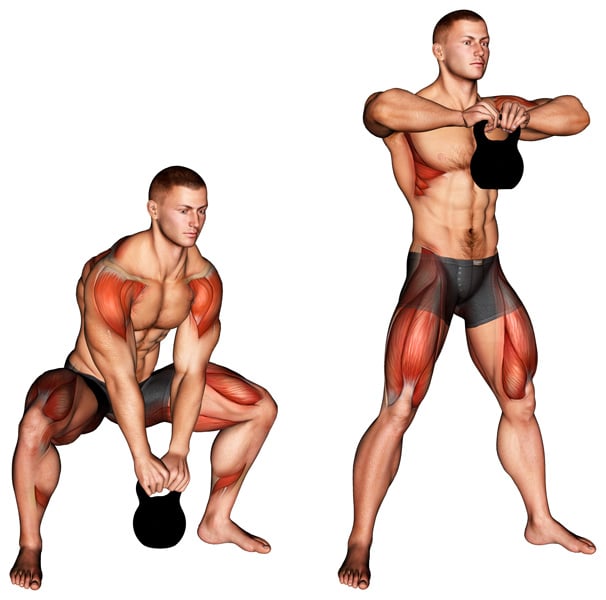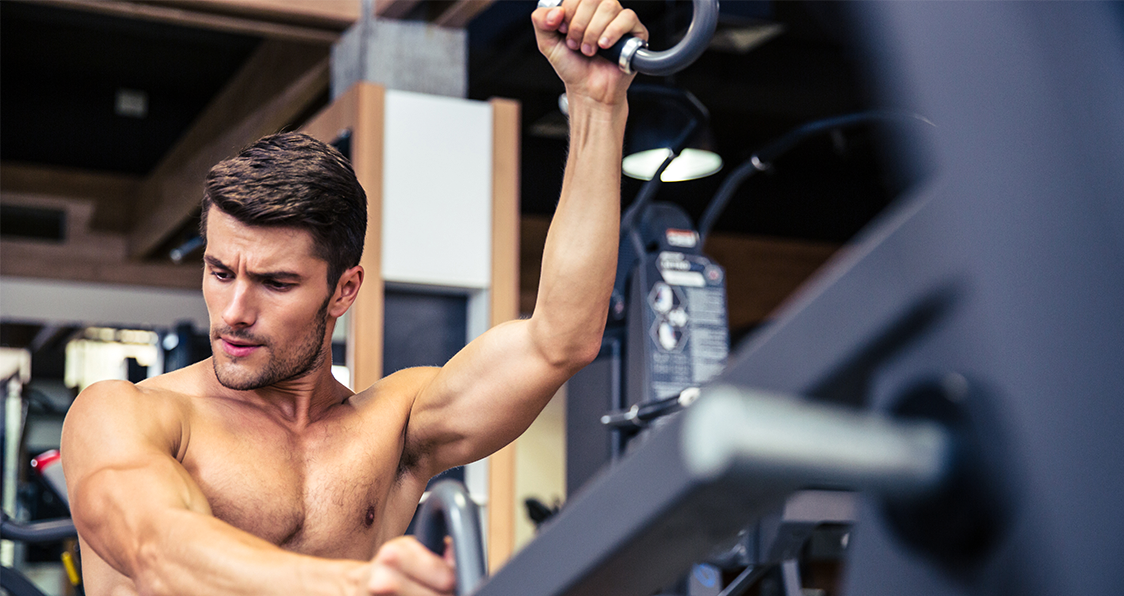Tag: compound

Kettlebell Sumo High Pull — How To, Variations and Muscles Worked
The kettlebell sumo high pull (or kettlebell sumo deadlift high pull) is a functional exercise that also builds strength and muscle throughout the entire body. It combines a deadlift and upright row, and, therefore isn’t just a simple movement which is why it’s so effective. Consequently, it’s not the best option for beginners to try…

Isolation Vs. Compound Exercises: Strength, Weight Loss & More
Both are great, but which one can better benefit your overall gains?
When you work out, you may not even think about isolation vs. compound exercises. You just do your workout in hopes of serious gains. But looking at and knowing the difference between these two types of exercises is important for they can each affect your gains in a different way. Many of the workouts we do perform include a mix of either isolation or compound exercises, but it is important to know the difference as we seek more specific goals.
Whether you want to work your entire body, a group of muscles, or simply target one muscle group, that all affects your gains. And this isn’t just because of strength. Other factors to functional movements and sport specific ones make a difference depending on which exercise you choose to perform. By focusing fully on exactly what you want to accomplish you can better tailor your workouts to see those specific goals achieved.
Let’s dive into isolation vs. compound exercises and see what makes these exercises so important. Knowing the differences and how they affect various aspects of your training like strength, weight loss, and more can give you the right approach to better tackle all of these workout wants and needs.
Compound Exercises Breakdown
Compound exercises are multi-joint movements designed to work several muscles and muscle groups all at once. These are typically those more complex movements with things like the squat, bench press, and deadlift, which require many muscles to work together in one movement to see the best results. If you talk to trainers and other experts, they will typically guide you into performing more compound movements as these translate well into functional and sport specific movements (1). For those looking to get a full body workout, compound exercises are the way to go.
Isolation Exercise Breakdown
Isolation exercises are those exercises that specifically target one muscle or muscle group as you perform it. While you can use free weights for these exercises, typically you will find machines at the gym to be more suitable to isolation exercises. Exercises under this category include bicep curls, triceps kickbacks, lateral raises, and many more. Anything that focuses solely on one muscle or muscle group and can specifically build strength and size directly is an isolation exercise. These are great for those wanting to work out while rehabbing an injury, work to fix any muscle imbalances, and isolate one muscle to see effective gains.
Compound Vs. Isolation Exercises…
For Strength
Compound exercises. Looking to build more efficient strength, a compound exercise works many muscles and muscle groups so you start to build well-rounded and more functional strength. Plus, you can lift more weight with more muscle engagement thus increasing time under tension and provide optimal resistance for serious growth (2).
For Muscle Imbalances
Isolation exercises. Since isolation exercises allow you to focus on one muscle or muscle groups at a time, you can work to fix any of those dreaded imbalances that hurt your physique. Say your chest is slightly off, work with a single arm movement, like the single arm bench press or single arm fly, to fix that imbalance. Or your triceps just aren’t quite on point. Consider triceps kickbacks or one arm cable pushdowns to really target that spot and fix an imbalance (3).
For Weight Loss
Compound exercises. For those wanting to burn calories and shed more fat, look to compound exercises. You work more muscles, get that heart rate going, start sweating more, and thus burn calories and work towards a more shredded aesthetic. Lifting heavy is a great way to change fat to muscle and compound exercises allow you to lift exponentially more weight than isolation exercises (4).
For Specific Isolation
Isolation exercises. This may seem obvious, but yes, isolation exercises will work to target a specific spot so all the attention is on that muscle. This is perfect for those who may find their arms are lacking. Consider biceps curls and triceps kickbacks, two isolation exercises to increase strength and size and work for those bigger, more defined arms.
For Inter-Muscular Coordination
Compound exercises. Get your muscles working together and build better coordination all around. By needing many muscles to work together to complete the lift, you start to build a cohesive unit for other movements, whether they be functional or more sport specific. This will help with better body development on the whole.
For Injury Recovery
Isolation exercises. Say you are rehabbing a hamstring injury, but still want to work out. Compound exercises, at least those involving your lower half, are out of the question. Use isolation exercises to still build strength and size, as well as getting a good workout, without feeling like your gains are suffering.
Best Supplements For Post-Workout Gains
After a workout consisting of compound exercises, isolation exercises, or both, it is best to try and supplement with the right products so you see those gains you want most. Your post-workout routine needs to be absolutely on point as you seek the best for all of your gains. A protein powder is something to be used to increased growth and overall recovery, while a mass gainer is something to take to really increase mass. With a large balance of macronutrients, a mass gainer will be perfect for a clean bulk. Others to consider are creatine and casein protein, for creatine can increase strength and size and casein will provide for that vital overnight repair.
Wrap Up
When it comes to isolation vs. compound exercises, knowing what these can do for you can make or break your gains. The right approach to training and knowing what you want can be a game changer especially when you start to get more specific with your goals. Whether it be for strength and weight loss, or more isolation and injury rehab, both isolation and compound exercises can have a great effects on your gains.
Let us know what you think in the comments below. Also, be sure to follow Generation Iron on Facebook, Twitter, and Instagram.
*Images courtesy of Envato
References
Kak, H.; et al. (2013). “A Study of Effect of the Compound Physical Activity Therapy on Muscular Strength in Obese Women”. (source)
Gentil, P.; et al. (2015). “Single vs. Multi-Joint Resistance Exercises: Effects on Muscle Strength and Hypertrophy”. (source)
Kim, T.; et al. (2015). “Effects of specific muscle imbalance improvement training on the balance ability in elite fencers”. (source)
Willis, L.; et al. (2012). “Effects of aerobic and/or resistance training on body mass and at mass in overweight or obese adults”. (source)

These Machines Are Better Than Free Weights
Use These Machines Rather Than The Free Weights
Machines can be incredibly helpful for some lifters, especially beginners. The machines are a form of isolation (single-joint) exercises that train a single muscle group. While using the free weights has its advantages, there are instances where you’d be better off using the machines.
You should consider using machines instead of performing the compound lifts if you’re recovering from an injury. On days when you feel tenderness or soreness (in a funny way) in your muscles, you should head straight towards the machine station.
Pec Deck Flyes
Many people waste their precious time and energy on performing the dumbbell flyes as they can’t feel any tension on their inner pecs. Establishing a mind-muscle connection can be harder while performing exercises with free weights.
Using the pec deck fly machine can give you a better pump as the range of motion is defined and all you have to do is focus on contracting your pecs with every rep. If you don’t end the exercise with a muscle tearing pump, you should try lowering the weights.
Machine Preacher Curls
Using machines takes away many moving parts from the equation like lifting with the right form, setting an appropriate range of motion, and the scare of hurting oneself if failure is hit during the exercise.
Cutting down these variables makes more space for the most important aspect of bodybuilding – focusing on the muscle under question. The machine preacher curls are a great exercise for training the peak of your biceps.
Lat-Pulldowns
Some people have trouble training their lats optimally. A good back workout should feel as brutal as an annihilating leg workout, if not more. Performing the pulling movements work the lats and build the width in your back.
The only real substitute to the lat pulldowns is the pull-ups. Lat-pulldowns are the perfect substitute for people who can’t perform bodyweight pull-ups or think that bodyweight chin-ups are too easy.
Tricep Cable Pressdowns
In exercises like the dumbbell kickbacks, skullcrushers, or any other free weight lift there are chances of the recruitment of secondary muscles like forearms and shoulders. The cable tricep pressdowns are an isolation exercise and can efficiently target the triceps.
You can get more tension on your triceps by performing the unilateral cable tricep extensions. In the unilateral version, you perform the tricep pressdowns with one arm before switching to the other. The unilateral exercises help in building symmetry and fixing muscle imbalances.
Ab Crunch Machine
Most people make the mistake of not treating their abs like they train all their other body parts. While they do 8-12 repetitions while training other muscles, they resort to doing 25-30 reps while working abs.
Using an ab crunch machine helps by defining a range of motion and gives you the freedom to focus on contracting your abdominal. Machines are better at helping you achieve a muscle pump as they provide the same amount of tension on the muscles throughout the range of motion.
Do you prefer compound or isolation exercises? Let us know in the comments below. Also, be sure to follow Generation Iron on Facebook, Twitter, and Instagram.
*Header image courtesy of Envato Elements
